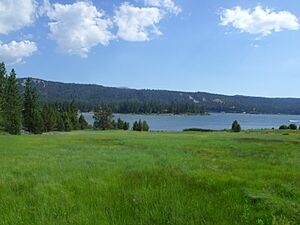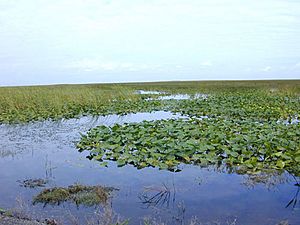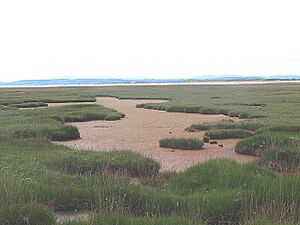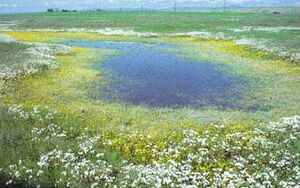Marsh facts for kids
A marsh is a type of wetland. It's like a shallow, watery area where you'll find lots of grasses, reeds, and other small plants growing. The water in a marsh is usually not very deep.
Marshes are different from swamps. Swamps usually have deeper water and more trees. In the United States, people often use the word 'swamp' for wetlands with many trees.

The water in a marsh can be fresh, a little bit salty (called brackish), or very salty (called saline). Marshes near the coast are often found near estuaries (where rivers meet the sea) or along waterways between barrier islands and the mainland. The soil in these coastal marshes can be sandy or made of soft mud.
Marshes are super important homes for many kinds of animals. They are often where animals go to have their babies and raise their young.
Contents
Types of Marshes Around the World
Marshes are different depending on where they are and how salty their water is. These two things greatly affect which plants and animals can live there. There are three main types of marshes: salt marshes, freshwater tidal marshes, and freshwater marshes. You can find these types all over the world, and each one has its own special plants and animals.
Salt Marshes: Coastal Wonders
Salt marshes are found in many places around the world, especially in areas with mild to cold climates. They grow along protected coastlines. These marshes are close enough to the ocean that the tides affect them. Sometimes, they are even covered by ocean water.
Salt marshes grow well where new soil and sand build up faster than the land sinks. They are mostly filled with special plants, like salt-tolerant grasses, that can live in salty water.
You often find salt marshes in lagoons, estuaries, and on the calm side of sand or shingle spits. The ocean currents bring tiny bits of sand and mud to these quiet spots, and they start to pile up. These marshes help clean the water by soaking up extra nutrients before they reach the ocean. Sadly, many salt marshes are disappearing because of buildings and cities growing along the coast.
Freshwater Tidal Marshes: River Meets Tide
Even though they are called freshwater marshes, these marshes are still affected by the ocean's tides. However, because the water isn't salty, many more types of plants and animals can live here compared to salt marshes. The biggest dangers to these marshes are the growing cities around them and the pollution they create.
Freshwater Marshes: Diverse Habitats

Freshwater marshes come in many sizes and are found in many places. They are the most common type of wetland in North America. They also have the most different kinds of plants and animals. Here are some examples of freshwater marshes you might find in North America:
Wet Meadows: Seasonal Ponds
Wet meadows are found in places like shallow lake beds, low areas, and the land between shallow marshes and higher ground. You can also find them along the edges of big lakes and rivers. Wet meadows often have many different kinds of plants. They get flooded regularly but often dry out in the summer.
Vernal Pools: Temporary Homes
Vernal pools are a type of marsh that only appears at certain times of the year. They form in shallow dips in the land. They can be covered in shallow water, but in the summer and fall, they might be completely dry.
In western North America, vernal pools often appear in open grasslands. In the east, they are found in forests. Further south, they form in pine forests. Many types of amphibians, like frogs, need vernal pools to lay their eggs in the spring. These ponds are safe because they don't have fish, which would eat the amphibian eggs and young. An example is the endangered gopher frog. Similar temporary ponds exist in other parts of the world and are often called vernal pools too.
Playa Lakes: Circular Basins
Playa lakes are shallow freshwater marshes found in the southern plains of the United States. Like vernal pools, they only have water at certain times of the year and are usually round. As the playa dries in the summer, different types of plants grow in rings along the shoreline.
Prairie Potholes: Glacial Gifts
Prairie potholes are found in the northern parts of North America, in a place called the Prairie Pothole Region. This area was once covered by glaciers. When the glaciers melted, they left behind many shallow dips in the ground. These dips fill with water in the spring. They are very important places for many kinds of waterfowl (ducks, geese, etc.) to breed. Some of these pools only have water for part of the year, while others stay wet all year long.
Riverine Wetlands: Along the Rivers
Many types of marshes grow along the edges of large rivers. Different factors like water level, nutrients, ice, and waves create these different marsh types.
Marshes in the United States
Marshes in Canada
Marshes in the United Kingdom
- Magor Marsh
- Insh Marshes
- Doxey Marshes
- Keyhaven, Pennington, Oxey and Normandy Marshes
- Minsmere–Walberswick Heaths and Marshes
- North Kent Marshes
- Romney Marsh
- Wilden Marsh
Related Topics
Images for kids
-
Green Cay Wetlands, Palm Beach County, Florida
-
Many kinds of birds nest in marshes; this one is a yellow-headed blackbird.
See also
 In Spanish: Ciénaga (humedal) para niños
In Spanish: Ciénaga (humedal) para niños










